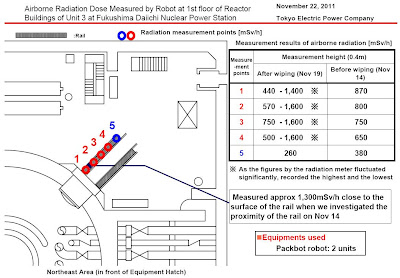Asahi Shinbun's "Trap of Prometheus" series is still on-going, and right now it's Part 3 about suppressing the scientific data. It continues to be an excellent article, and it continues to be printed on the "third page" (see my post on the Part 1 of the series).
I just finished reading the Part 2 "Resignation of a Researcher", which has 21 installments. Even though Asahi Shinbun is busy taking down the blog sites that compile all the series articles for convenient reading, they cannot suppress them all, and I read it on this blog.
In it, there is a very curious piece of information about SPEEDI simulation, the NISA and the PM's Office's decision to set the evacuation zone in concentric circles. In short,
The Ministry of Education had ordered the SPEEDI simulations from the beginning and knew exactly where to send the official to do the actual measurements in Namie-machi, Fukushima;
Not only the Ministry of Education ordered SPEEDI simulation calculations but also the Nuclear and Industrial Safety Agency ordered its own SPEEDI simulation calculations with much more accuracy;
NISA was setting the evacuation zone on March 11 evening based on the simulation;
NISA stopped their work as soon as the PM's Office, based on no credible information or agreed-on procedure, announced the concentric circle evacuation zones.
Reading the Part 2 of the series, it sure looks as if almost everything bad that happened afterwards could have been prevented if the politicians and bureaucrats on the initial (and crucial) 1st and 2nd days of the nuclear accident had acted to protect the public, which I think is their constitutional duty. Instead, they played games, a turf war as if this was just another ordinary day in Kasumigaseki.
This post is my quick translation of the Installment 11. Installments 12, 13, and 14 will be in the next 3 posts.
研究者の辞表(11)ピンポイントの指示
"Resignation of a Researcher" (11) Instruction with pinpoint precision
放射線衛生学の研究者、木村真三(44)らが福島に入った3月15日は、朝6時すぎに福島第一原発の2号機が破損、大量の放射性物質が放出されていた。
Shinzo Kimura and others entered Fukushima on March 15. That day, Reactor 2 at Fukushima I Nuclear Power Plant was damaged at around 6AM and a large amount of radioactive materials were being released.
原発から5キロの場所には11日夜に国の現地対策本部ができていた。しかし14日夜には2号機の状態を懸念して撤退方針を決める。同日夜から撤退を始め、15日午後には原発から60キロ離れた福島県庁に退いた。
At a location 5 kilometers from the plant, the headquarters for nuclear disaster countermeasures was set up by the national government in the evening of March 11. However, in the evening of March 14, they decided to retreat out of fear of the condition of Reactor 2. The retreat started that night, and the headquarters was moved inside the Fukushima prefectural government building, 60 kilometers from the plant, by March 15 afternoon.
撤退組の一人、渡辺眞樹男(57)は福島県庁に移った後の15日夜に指示を受けた。「大変な事態になっている。測定に行ってくれ」
Makio Watanabe, one of the officials at the headquarters, received the instruction on March 15 evening at the Fukushima prefectural government building. "The situation is extremely serious. Go measure the radiation."
渡辺は文部科学省茨城原子力安全管理事務所から応援に来ていた。指示された場所は浪江町山間部の3カ所。ピンポイントだった。神奈川北原子力事務所の車 で現地に行き、午後9時ごろ放射線量を測る。数値を見て驚いた。3カ所とも高く、特に赤宇木(あこうぎ)は毎時330マイクロシーベルト。
Watanabe had been sent to the headquarters from the Ministry of Education's office for nuclear safety management in Ibaraki. He was instructed to go and measure at 3 locations in the mountainous area in Namie-machi. The instruction was pinpoint, very precise. He drove there, and start measuring the radiation at about 9PM. He was alarmed to see the numbers. All three locations had very high radiation, and Akogi District in Namie-machi measured 330 microsieverts/hour.
「いやもう、信じられなかった」と渡辺は振り返る。すぐ報告しようとしたが、携帯はつながらない。雨模様だったので衛星携帯も使えなかった。急いで川俣町の山木屋まで戻り、公衆電話から報告をした。戻る途中、点々と人家の明かりが見えた。まだ大勢の人が残っていた。
Looking back, Watanabe says "I just couldn't believe it." He wanted to report right away, but his cellphone didn't connect. He couldn't use his satelite phone because it was raining. He hastily drove back to Kawamata-machi, and used the public phone there to report. On the way back to Kawamata-machi, he saw lights in people's houses. There were still many people remaining [in Namie-machi].
「とにかく住民の方々に被曝(ひばく)をしてほしくなかった。線量が高いと報告し、早くこの線量を発表してください、とお願いをしました」
"I just didn't want the residents to get irradiated. I reported that the radiation levels were extremely high, and asked the headquarters please to make the radiation measurements public as soon as possible."
実はこのとき渡辺は防護服を着ていなかった。県庁への撤退が慌ただしかったため、防護服の類は現地本部に放棄していたからだ。
Watanabe wasn't even wearing the protective clothing. Since the retreat to the Fukushima prefectural government building was done so hastily that they left protective gear.
「不思議と自分のことは考えていないですよね。こんな時だからこそやらなきゃいけない、と」
"I didn't think about my safety at that time. I felt I had to do it."
必死の思いで渡辺が伝えた数値は、しかし住民避難に使われはしなかった。文科省は16日にその数値を発表したが、地区名は伏せたまま。浪江町に知らせる こともなかった。町は危険を認識せず、一帯に残る住民に伝えることもなかった。なにより官房長官は「直ちに人体に影響を与えるような数値ではない」と会見 で述べていた。
However, the numbers that Watanabe had measured at grave danger and reported were never used for evacuation of the residents. The Ministry of Education announced the numbers on March 16 but it didn't say exactly where. The Ministry never notified Namie-machi. Namie-machi didn't know the danger, and so it didn't inform the residents about the danger. More than anything else, the Chief Cabinet Secretary [Edano] kept saying in the press conference, "They are not the levels that would affect the body immediately."
それにしても、なぜ対策本部は高線量の場所をピンポイントで知っていたのか。渡辺は言う。「ポイントをどなたが決めて指示されたのか、私もいまだに分かりません」
Still, how come the headquarters knew the locations of high radiation with such precision? Watanabe says, "Who decided which point to measure and instructed me? I do not know even this day."
元をたどると、指示は文科の本省だった。根拠に使われたのはSPEEDI(緊急時迅速放射能影響予測システム)。同省は汚染の概要をつかんでいた。(依光隆明)
The reporter tracked down the source, and it was from the Ministry of Education in Tokyo. The instruction was based on SPEEDI, and the Ministry knew the extend of radiation contamination.
I remember the face of Yukio Edano in the press conferences in the early days of the accident. He was saying "No immediate effect". People were relieved. People even worried for his health, and told him to get some sleep. Then one day in mid April, there was a news clip of him visiting Fukushima (Minami Soma City), with protective clothing and a face mask. People ridiculed him at first, for it seemed to contradict his statement of "no immediate risk".
He knew. And he lied. And people know that now, albeit too late.










 Tokyo Time
Tokyo Time
![[Most Recent Quotes from www.kitco.com]](http://www.kitconet.com/charts/metals/gold/t24_au_en_usoz_2.gif)

